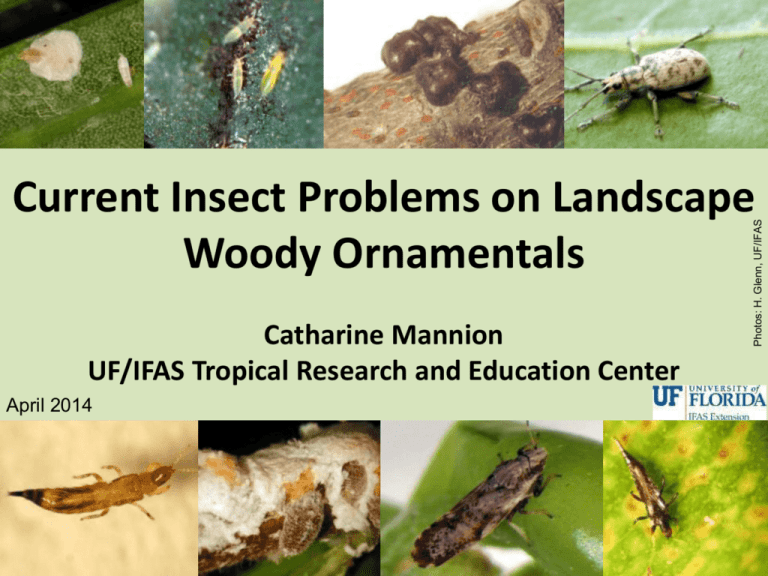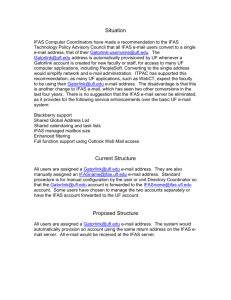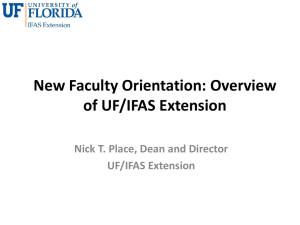Pesticide Resistance - University of Florida
advertisement

Catharine Mannion UF/IFAS Tropical Research and Education Center April 2014 Photos: H. Glenn, UF/IFAS Current Insect Problems on Landscape Woody Ornamentals The Landscape A Reservoir of Pests Also a reservoir of natural enemies Proper identification of The problem The pest CRITICAL for successful management Invasive Pests are one of our biggest pest problems • Due to mild climate and diversity of plants, new insects become easily established • Approximately 1-2 new pests introduced each month Pest Damage Photos by Glenn, UF Do not always blame insects for damage. Other critters can also cause damage! Photos by Glenn, UF Who did this? Photos: H. Glenn, UF/IFAS Eggs Pupae/cocoons Cast skins Webs Frass Secretions Galls Same insect ? YES Scale – females and males Photos: H. Glenn, UF/IFAS Photos: H. Glenn, UF/IFAS Same insect ? YES Whiteflies PUPA (NYMPH) Photo: H. Glenn, UF/IFAS Photos: H. Glenn, UF/IFAS ADULT Same insect ? YES YES Photos: H. Glenn, UF/IFAS All the same insect – Lobate lac scale Photos: H. Glenn, UF/IFAS What is this? In addition to recognizing pests, you need to recognize the “good guys” Pest ? YES NO Photos: H. Glenn, UF/IFAS Pest ? YES NO Pest ? YES NO Photos: H. Glenn, UF/IFAS Pest ? YES NO Photos: H. Glenn, UF/IFAS Stock Island tree snail Which snail is the pest? Which snail is endangered? Giant African land snail Photos: Bill Frank, www.jaxshells.org, D. G. Robinson, APHIS, Amy Roda, USDA APHIS Is it a Pest ? • No physical characteristics that define a pest • Need to look at where it is and what it is doing • Need to be familiar with the common pests/natural enemies • Invasive pests are difficult – When in doubt – send to a proper authority Awareness of new pests is very important. Of 150 species introduced into Florida during 1986-2002, 57% were first found in Monroe, MiamiDade, Broward, or Palm Beach Counties. 27 new pests were reported for 2009-2010 The Biggest Invaders • Hemiptera (Suborder Sternorrhyncha) Photos: H. Glenn, UF/IFAS – Psyllids, whiteflies, aphids, scales, mealybugs – Often cover themselves in wax or froth 2012 2011 2010 2009 2008 2007 2002 1999 1996 Honeysuckle whitefly Bondar’s nesting whitefly Passionvine mealybug Ash whitefly Rugose spiraling whitefly Nipaecoccus viridis (mealybug) Croton scale Ficus whitefly Pink hibiscus mealybug Bamboo mealybug Lobate lac scale Cycad aulacaspis scale Giant whitefly The Biggest Invaders • Coleoptera (beetles) 2012 2009 2005 2000 Asiatic garden beetle Ambrosia beetle (Xyleborinus andrewesi) Redbay ambrosia beetle Sri Lankan weevil P. Skelley, A. E. Mayfield III, M. C. Thomas, FDACS DPI; J. Hulcr, MSU, forestryimages.org; H. Glenn, UF/IFAS The Biggest Invaders • Thysanoptera (thrips) 2006 2005 2003 H. Glenn and L. Osborne, UF/IFAS Holopothrips tabebuia Chilli thrips Weeping ficus thrips The Biggest Invaders • Mites 2013 2007 2001 Phyllocoptes fructiphilus (vectors/associated with rose rosette virus) Red palm mite Eutetranycus sp. (spider mite) Hemipteran Pest Damage (aphids, whiteflies, scales, mealybugs) • Changes in foliage – Discoloration, spots, stippling, yellowing, bronzing) • Defoliation and branch dieback • Overall plant decline • Plant death – Prolonged infestations – Secondary stress Signs of Infestation by Hemipteran Pests • Cast skins • Mummies • Wax • Tar spots • Honeydew • Sooty mold Photos: H. Glenn, UF/IFAS Management Hemipteran Pests • Early detection – Often cryptic; not noticed until populations are high • Many have waxy secretions/coverings that provide protection • Wash with water • Insecticidal soaps and oils – need good coverage/repeat application • Biological control • Insecticides - systemic vs. contact Management of Pests with Systemic Insecticides • Several application methods and formulations – Soil application (drench, granular, pellets, injection) – Trunk application (basal spray, injection) – Foliar application • Excellent tools for pest control – Can provide long term control – Prone to overuse Drench Injection Granular Trunk spray Neonicotinoids (MOA 4A) Whitefly Management Active Trade Names Ficus, Rugose Spiraling and Bondar’s Nesting Whiteflies Ingredient Professional Use Acetamiprid TriStar (no soil application) Clothianadin Arena, (Aloft – no longer available in Florida) Dinotefuran Safari, Zylam Imidacloprid Merit, Marathon, Coretect, Discus, Allectus, several generic labels Thiamethoxam Flagship, Meridian Pest Groups Targeted • Hemiptera – Adelgids – Aphids – Bugs – Leafhoppers – Mealybugs – Psyllids – Scales – Whiteflies • Coleoptera – Beetles – Weevils • Others – Ants – Fungus gnats – Craneflies – Leafminers – Thrips Using Neonicotinoid Insecticides • There is no “best” a.i. or method - take advantage of the different methods and formulations • Fit the method(s) of application for the site • The site and method needs to be on the label • Consider the methods that gets the needed result with the least negative impact on the environment/non-targets Neonicotinoid Applications Applied to the foliage Applied to the trunk Applied to the soil Movement of the insecticide is upwards Neonicotinoid Insecticides • Application to coconuts (or fruits) – Landscape: ornamental vs edible plant • Effects on pollinators (particularly bees) – Toxic to bees – Systemic applications –use lowest effective dose – Avoid use on tree species highly attractive to pollinators; Use after bloom – Impact of other types of insecticides • EDIS ENY-162 Minimizing Honey Bee Exposure to Pesticides Honey Bee Health USDA and EPA 2013 • There are multiple factors playing a role in honey bee colony decline • Forces impacting honey bee health are complex – Parasitic Varroa mite – major factor – Bee viruses – major factor – Poor genetic diversity – Poor nutrition among honey bee colonies – Need to determine actual pesticide exposure and effects to bees in the field Insecticide Resistance • Resistance to insecticides - not a new problem • Ongoing efforts with pyrethroids and neonicotinoids, the two biggest selling classes of insecticides • Repeat application (particularly in multiple generations) • Exposure to sublethal (less than optimal) pesticide rates • How does systemic use affect resistance? Arthropods Prone to Resistance Development • Mites, aphids, whiteflies, and thrips – Many generations per year – Exposure of multiple generations to a pesticide – Produce many offspring – Limited dispersal – Exposure to sublethal (less than optimal) pesticide rates Resources on Insecticide Resistance • Managing Insecticide and Miticide Resistance in Florida Landscapes - http://edis.ifas.ufl.edu/in714 • Management of Insect and Mite Resistance in Ornamental Crops - http://edis.ifas.ufl.edu/in715 • A Dresser Drawer Method of Managing Insect and Mite Resistance in Ornamentals http://edis.ifas.ufl.edu/in773 • IRAC’s Insecticide Mode of Action classification http://edis.ifas.ufl.edu/pi121 Biological Control • Natural first line of defense • Conservation of natural enemies – Everything you do has some impact – Reduce negative impact • Release natural enemies – Requires knowledge of both the pest and natural enemy Pest Group Natural Enemies Aphids Aphid midge, lady beetles, lacewings, minute pirate bug, parasitic wasps, microbial insecticides Broad mites Predaceous mites Mealybugs Wasp parasites, lacewings, beetle predators (mealybug destroyer) Scale insects Lady beetles, wasp parasites Spider mites Lacewings, predatory mites Thrips Wasp parasites, lacewings, microbial insecticides, minute pirate bug; predatory mites Whiteflies Lacewings, wasp parasites, predaceous beetle larvae, microbial insecticides Integration of Biological Control and Pesticides • Most broad spectrum insecticides are toxic to arthropod natural enemies • Fungicides are toxic to many entomopathogens • Acaracides and pyrethroids – most harmful to predatory mites • Pyrethroids – selective on most lacewings; mixed results on other predators and parasites Integration of Biological Control and Pesticides • Organophosphates – toxic to most arthropod natural enemies • Botanicals – mixed effect on natural enemies; some selection • Growth regulators – usually more specific; some selection • Neonicotinoids – low to moderate (depends on application) Impact of “Lower Risk” Pests • • • • Risk of spreading into production areas High visual or local impact Public, press and politic pressure Yet, not considered national risk (lack of funding or resources) • Could be more problematic in isolated areas • Reliance on pesticides Established Pest Populations • These pests are not going away • Expect populations to go down (takes years) • May always have “hot spots” • Diverse landscapes – Overplanting anything (including native plants) can create a problem • Select trees with less problems (but this is dynamic and can change; i.e. ficus) • Strive for biologically based, long-term pest management Web Resources • http://trec.ifas.ufl.edu/mannion • http://mrec.ifas.ufl.edu/lso/IAWG/ • http://edis.ifas.ufl.edu/ • http://creatures.ifas.ufl.edu/ • Pest Alerts – University of Florida (http://extlab7.entnem.ufl.edu/pestalert/) – DOACS (http://doacs.state.fl.us/~pi/enpp/pipest-alert.html) Whitefly Update Photos: H. Glenn, UF/IFAS Ficus Whitefly Photo: H. Glenn,, UF/IFAS Ficus Whitefly • • Only feeds on ficus Causes leaf yellowing, leaf drop and branch dieback Photos: W. Schall, Palm Beach County Extension A Word About Ficus • Overplanted • Increased problems – – – – – Plants not recovering Planted in poor locations Heavily pruned Under/over maintained Cumulative stress ? • Many new pests – Ficus thrips (2003); Leaf gall wasp (2003); Ficus whitefly (2007); Fig wax scale outbreaks (2007); gall midge (2008); Bondar’s nesting whitefly (2011) and others (lobate lac scale, croton scale) Ficus Whitefly Update • Can be difficult to see whitefly building up until damage is apparent • Damage is most obvious in late summer and fall • Typically populations go down in the winter • Appears to be getting worse in many areas since last year. Photos: H. Glenn, UF/IFAS Rugose Spiraling Whitefly Photos: H. Glenn, UF/IFAS Rugose Spiraling Whitefly • • Makes a big mess Produces white, waxy flocculent substance Photo: H. Glenn, UF/IFAS Rugose Spiraling Whitefly • • Excretes a sticky, clear substance called honeydew Sooty mold grows on the honeydew Photos: H. Glenn, UF/IFAS Rugose Spiraling Whitefly • More than 90 different plant hosts reported • Favorites: – Gumbo limbo – Coconut – Bird of Paradise – Calophyllum spp. – Various other palms • • • • Christmas Alexander Montgomery Adonidia Photos: H. Glenn, UF/IFAS Rugose Spiraling Whitefly Update • Populations naturally go down in the winter • Populations are decreasing overall – Management – Natural enemies – 3 parasitic wasps and one predatory beetle identified but one is very active (Encarsia noyesii) – Martin, Miami-Dade, and Broward Counties all reporting decline of this whitefly Photo: S. Taravati, UF/IFAS Bondar’s Nesting Whitefly Photos: H. Glenn, UF/IFAS Bondar’s Nesting Whitefly • Not known as economic pest • Often seen with other whiteflies • Other species known in Florida Photos: H. Glenn, UF/IFAS Catharine Mannion Research and Extension Specialist Ornamental Entomology University of Florida, IFAS Tropical Research and Education Center 18905 SW 280th Street Homestead, FL 33031 305-246-7000 cmannion@ifas.ufl.edu http://trec.ifas.ufl.edu/mannion




